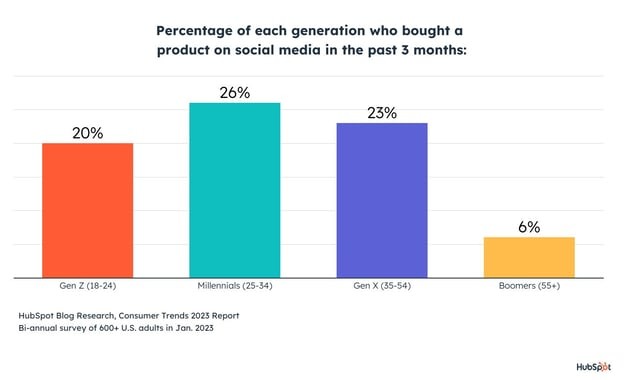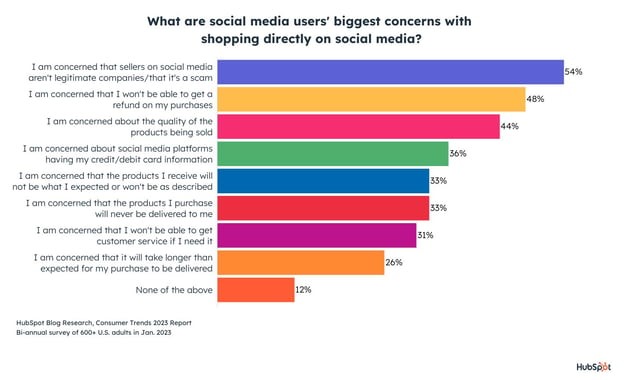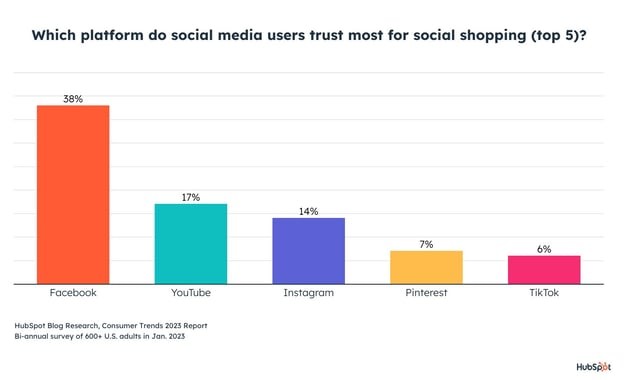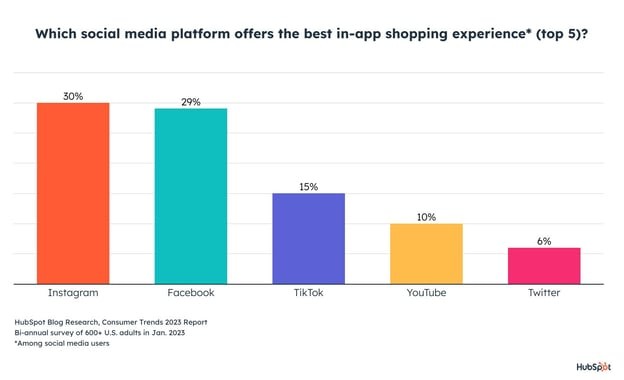If you’ve been on social media lately, you know shopping has taken center stage on most platforms.
But, social commerce a controversial topic -- some people love it, others are exhausted by product placements everywhere. And, in our latest research, we discovered that people don’t trust the social media apps they use daily to handle their purchases.
How Consumers Feel About Social Media Shopping
For starters, just 41% of social media users feel comfortable buying products directly on social apps, and only 37% trust platforms with their card info.
And when it comes to the products sold directly on social platforms, just 21% of social media users view them as high-quality.

Still, around one in five social media users buy on social media regularly, and 75% of those shoppers say they're satisfied with their latest purchase.

So why are people so suspicious of social shopping? Let’s take a look at the biggest concerns consumers have with shopping on social, how you can address them, and which platforms are most trusted for shopping.
The Biggest Social Shopping Concerns
By far, the biggest concern of consumers is that companies selling products directly on social media aren’t legitimate or could be scamming customers.
As mentioned above, suspicions regarding the quality of the product and sharing card information with social platforms also play a huge role.

On top of that, one-third of social media users are concerned that their purchase will never be delivered, and the same amount worry about the item will not be as described when and if they do get it.
What Can Social Sellers Do to Build Trust?
1. Make and Stand By Customer Promises
First, directly address common consumer objections or concerns by promising and following through on guarantees like:
- a set, transparent, and explainable shipping speed
- Refunds and/or replacement warranties
- Customer service availability (ideally on multiple channels)
While this step is a foundational standard that most businesses should follow, the promises above won’t be enough to gain full trust, especially if you’re a brand selling exclusively on social.
2. Build Community
The next step is to foster a trusting community with your audience.
You can do this by responding to their comments or questions, addressing concerns in review responses, and asking your community for feedback. You should also aim to build content strategies fueled with funny, relatable, and valuable posts that are relevant to your prospects andd show the humanity behind your brand, without making the content feel like an ad.
For example, if you sell peanut butter, make a poll on your story about crunchy vs. smooth to end the debate once and for all. Or create a short video chock-full of fun facts about peanuts: (Did you know astronaut Alan Shepard once brought a peanut to the moon and back?).
Encourage Customer Engagement and UGC
Time and time again, research has shown that word of mouth, recommendations from loved ones, and product reviews from trusted, or relatable, sources can drive consumers through their buyer's journey. And, this makes sense: Are you more likely to trust a random website selling your a product, or a friend who already used that same item?
With this in mind, encourage happy customers to provide positive reviews or user-generated content to build social proof that your product is legitimate and customers are satisfied with it.
Similarly, try working with small influencers with niche, tight-knit communities related to your product – their stamp of approval can help bridge the trust gap.
Zone in on the Right Channels
When it comes to social selling you also have to consider the platform you’re using, because they aren’t all equally equipped for social commerce just yet, and different audiences are looking for different things.
For example, products you prioritize selling on Facebook, where the demographic skews older, might be different from products you'd sell on a Gen-Z-heavy platform like TikTok. Like content preferences, consumers also trust certain platforms to a different extent – especially when giving personal or credit card information.
Next, let’s take a look at the platform consumers trust most for shopping.
Most Trusted Social Shopping Platforms
Facebook has the most trusted social shopping platform, according to 38% of social users. YouTube comes in 2nd place (17%), followed by Instagram (14%).

Though not exactly the same as social shopping (where you buy directly in the app), it's important to remember that people have been buying things through Facebook Marketplace for a while now, while shopping experiences on other platforms are much newer and have catching up to do. So, now, with Facebook Shops, it feels much more natural to start using your credit card to purchase items on a platform that's already built robust shopping experiences with Marketplace.
One interesting thing to note is that Facebook and Instagram (both owned by Meta) have the same in-app shopping technology and platform, while one is adapted for Facebook, Instagram's is adapted to Instagram features, Instagram business pages, and UX. However, Instagram has far less trust than Facebook.
Why could this be? We aren't sure, but one guess could be the age, trust, and sheer size of Facebook – which Instagram could likely catch up to. It will be interesting to see if Instagram ultimately gains more shopping trust due to its growing age, credibility, and product purchasing features in the coming years. So
Channels with the Best Social Shopping Experience
We also asked social media users, which platform has the best in-app shopping experience, and Instagram (despite its lack in consumer trust) came out on top with 30% of the vote, followed by Facebook (29%), and TikTok (15%).

This makes sense as Instagram has been a leader in the social shopping space, though it seems users are somewhat skeptical of the quality of the products being sold on the app. While shopping features and product placements were a key part of Instagram's cultural and UX evolution, platforms like Faccebook and YouTube started with a focus on content and user experience – and eventually worked shopping in.
What's Next for Social Shopping?
The good news is social shopping is still evolving, so there’s plenty of time to build trust with social media users.
For more insights, check out our Social Media Trends Report or the full Consumer Trends Report.
And if you’re setting up shop on Instagram, head over to the Instagram Shopping Report for a deeper dive into selling on the app and which tools offer the best ROI.
Lastly, for overall coverage on the latest social media trends and tips from experts in the social marketing industry, download our full Social Media Report below.

